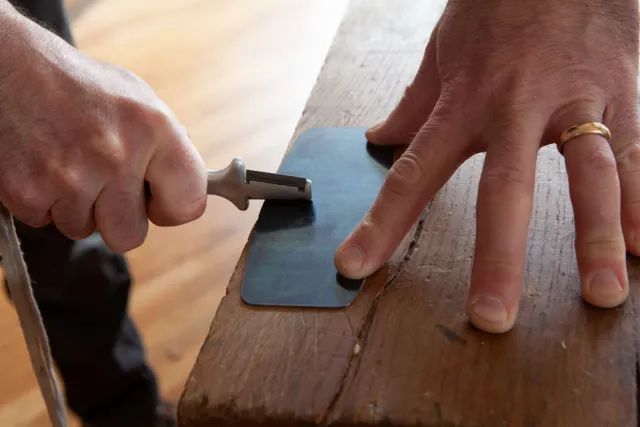How Do You Use A Hand Scraper For Wood?
A hand scraper is a single-edged tool used to scrape and smooth wood or other materials (https://en.wikipedia.org/wiki/Hand_scraper). Hand scrapers allow for controlled removal of material and can create a smooth, even surface on wood. They are commonly used in woodworking for surface preparation and finishing.
There are a few key reasons to use a hand scraper on wood:
-Removes small amounts of material precisely, without removing too much wood
-Creates a very smooth surface by slicing off high spots and ridges
-Leaves a crisp, clean edge on contours and details
-Does not overheat or burn the wood like sanding can
-Environmentally friendly and creates less dust than power sanders
The basic process involves preparing the wood, sharpening the scraper, holding the tool properly, applying strokes, and maintaining the scraped surface. This provides an overview of using a hand scraper effectively for different types of wood and finishes.
Choosing the Right Scraper
There are a few key considerations when selecting a hand scraper for woodworking:
Shape – Scrapers come in various shapes like rectangular, triangular, curved, etc. A rectangular scraper works well for large flat surfaces while a curved one is better for contoured areas. Triangular scrapers can get into corners nicely.
Material – Scrapers are typically made from high carbon steel, carbon steel, stainless steel or carbide steel. High carbon steel holds a very fine edge but may be more prone to rust. Stainless steel is corrosion resistant but doesn’t get as sharp [1].

Handle – Choose a comfortable handle size and grip. Some handles flare out to provide knuckle clearance.
Some common types of wood scrapers include:
– Cabinet scrapers – Thin and flexible with a burr on the edge. Excellent for fine finishing work.
– Card scrapers – Rigid rectangular scraper good for large flat surfaces.
– Detail scrapers – Smaller scrapers in various shapes for detailed work.
– Curved scrapers – For contouring and shaping wood.
Card and cabinet scrapers are likely the most versatile options for general woodworking. Curved and detail scrapers serve more specialized purposes but can be useful additions [2].
Preparing the Surface
Properly preparing the wood surface before scraping is crucial for achieving the best results. According to Fine Woodworking, sanding or planing the wood beforehand helps remove any rough areas and creates a uniform surface for scraping (https://www.finewoodworking.com/project-guides/finishing/sand-scrape-or-plane). Pay attention to the direction of the wood grain when sanding and make sure to go with the grain. Once sanded, thoroughly clean off any dust using a vacuum, tack cloth, or compressed air. Dust left on the surface can create scratches or an uneven finish when scraping commences.
Sharpening the Scraper
Sharpening the cutting edge of the scraper is crucial for it to function properly and achieve a smooth finish. There are a few key techniques to sharpen the edge correctly:
First, file the edge perpendicular to the face of the scraper at a 90 degree angle. Use a flat mill file and apply even, consistent strokes (Source 1). This removes any roundedness from previous use and creates a fresh, square edge.
Next, burnish or roll the edge to form a burr or hook. This can be done with a burnisher tool or the edge of a coin. Apply pressure while moving the tool from one side of the edge to the other. Repeat this motion until a thin burr forms (Source 1). The burr is what allows the scraper to effectively shear off thin shavings.
To maintain sharpness during use, periodically refresh the edge by burnishing again. This reforms the burr as it wears down. Avoid touching the cutting edge to prevent dulling it. Store the scraper safely when not in use.
With the proper sharpening techniques, the scraper will stay keen and ready to produce that glass-like surface.
Holding and Stroking
Proper hand scraper technique requires attention to grip, pressure, and stroking method. Grip the handle near the blade end, keeping your thumb along the top edge for control. Use your less dominant hand to steady the wood surface. Apply enough downward force so the blade edge stays in constant contact with the wood without excessive digging in. The pressure should come from your arm and upper body, not just your hands and wrists.
Use long, smooth strokes in the direction of the wood grain. Overlap each stroke slightly to ensure you cover the entire surface evenly. Lift the blade at the end of each pass. Avoid short, choppy strokes that can leave grooves. Stroke the scraper at a low angle, around 15-30 degrees. The optimal angle depends on the wood type, blade sharpness, and desired finish.
Maintain a steady scraping rhythm. Work systematically across the wood surface in bands. Pay attention to any areas where the grain changes direction. Adjust your stroke direction accordingly. Applying the scraper properly takes practice to develop the right touch and pressure. With experience, you can achieve a beautifully smooth finish.
Source: https://www.mmsonline.com/articles/the-art-and-science-of-hand-scraping
Scraping Different Wood Types
When using a hand scraper, you may need to adjust your technique based on whether you are working with hardwood or softwood.
With hardwoods like oak, maple, and cherry, you can apply more scraping pressure and achieve a smoother finish in fewer strokes. The dense grain of hardwoods allows the scraper to shear off thin, consistent shavings.
Softwoods like pine, fir, and cedar require a lighter touch. Take care not to dig in too aggressively with the scraper, which can tear up the wood’s softer grain. Use gentler strokes and progress gradually to the desired smoothness.
Some wood grains can pose challenges when scraping by hand. Curly grains may cause the scraper to skip randomly across the surface rather than cutting a uniform shaving. In these cases, try angling the scraper so it cuts across the grain at a diagonal. Grains with wild knots and swirls may simply need to be approached slowly and meticulously.
Regardless of wood type, always inspect and resharpen your scraper if it starts to drag across the wood without cutting well. A sharp edge is essential for effective scraping. Adjusting the hook angle or depth may also help with difficult grains. With practice and patience, you can achieve an ultra-smooth hand-scraped finish on any wood’s unique grain patterns.
Achieving a Smooth Finish
After scraping the wood in the direction of the grain, rotate your work 90 degrees and scrape perpendicular to the grain to remove any ridges. You may need to repeat scraping in both directions to get a perfectly smooth surface.
Rub the surface with your hand to check for any small ridges or uneven spots you may have missed during scraping. Go back over these spots again with the scraper pressing firmly to level them out.
For an ultra-smooth finish, do a final pass with fine grit sandpaper like 220 grit or higher. Sand with the grain using light pressure. Be careful not to press too hard or you may risk scratching the surface after all that careful scraping.
You can apply a protective finish like an oil, wax, or varnish once the surface is smoothed to your liking with the scraper and sandpaper. Allow the finish to fully cure as directed, and enjoy your glassy smooth wood surface.
Scraper Maintenance
Proper maintenance is crucial for ensuring your hand scraper continues performing at its best. Over time, the cutting edge will dull and may accumulate residue that can hamper performance. Here are some tips for keeping your hand scraper in optimal condition:
Regularly clean your scraper after each use by wiping off any debris, paint or glue with a damp cloth (https://www.wonkeedonkeetools.co.uk/floor-and-wall-scrapers/scraper-care-and-maintenance). Allow the scraper to fully dry before storing.
Store the scraper in a dry place, protected from moisture. Many recommend lightly oiling the blade and wrapping it in cloth or paper before storage to prevent rust (https://www.lie-nielsen.com/products/handscrapers-hand-scraper-set-).
Periodically inspect the cutting edge. When it starts to dull or round over, it’s time to re-sharpen. Use a file or sharpening stone to restore a clean, straight edge.
With regular re-sharpening, a quality hand scraper can last many years. However, if the blade becomes too short, warped or otherwise damaged, it may need replacement.
By properly cleaning, storing and maintaining your hand scraper, you can keep it performing like new for extended use.
Safety Tips
When using a hand scraper, it’s important to keep safety in mind to avoid injuries. Here are some key tips:
Protect your hands and fingers – Wear cut-resistant gloves to protect your hands while scraping. Also be careful to keep fingers away from the cutting edge of the scraper blade. Accidental contact can cause severe cuts.
Use proper body mechanics – Stand with a solid stance and avoid overreaching with the scraper. Make repeated light strokes instead of bearing down hard. This will help prevent muscle strains.
Secure the workpiece – Clamp the wood securely to a stable workbench before scraping to prevent slippage. Trying to scrape an unsecured workpiece could lead to hand injuries from accidental contact with the blade.
For more safety tips, refer to the manufacturer’s instructions. Following proper techniques and using caution will help make hand scraping a safe and effective woodworking process.
Conclusion
Learning to properly use a hand scraper can provide many rewards. Hand scraping wood allows you to refinish and restore antique furniture or wood surfaces in your home. It gives you greater control compared to power sanders, allowing you to target problem areas while preserving the wood’s character. Hand scraping produces a smooth surface while retaining the beauty of the natural grain.
To use a hand scraper effectively, first choose the right shaped scraper for the job. Prepare the surface by removing any existing finish. Sharpen the scraper’s blade at a 25-30 degree angle before each use. Hold the scraper at a 45 degree angle to the wood’s grain and apply even pressure as you stroke away from yourself in the direction of the grain. Adjust your scraping angle and technique for different wood types. Always scrape in the direction of the grain to avoid tear out.
Maintain your hand scrapers by honing the edges with a burnisher and protecting the blade when not in use. Follow key safety tips like wearing gloves and safety glasses. With practice, you can achieve professional quality results. For more guidance, refer to online tutorials or pick up a book dedicated to hand scraping wood.





